Jungyeon Kim
FDD Massive MIMO: How to Optimally Combine UL Pilot and Limited DL CSI Feedback?
May 14, 2024



Abstract:In frequency-division duplexing (FDD) multiple-input multiple-output (MIMO) systems, obtaining accurate downlink channel state information (CSI) for precoding is vastly challenging due to the tremendous feedback overhead with the growing number of antennas. Utilizing uplink pilots for downlink CSI estimation is a promising approach that can eliminate CSI feedback. However, the downlink CSI estimation accuracy diminishes significantly as the number of channel paths increases, resulting in reduced spectral efficiency. In this paper, we demonstrate that achieving downlink spectral efficiency comparable to perfect CSI is feasible by combining uplink CSI with limited downlink CSI feedback information. Our proposed downlink CSI feedback strategy transmits quantized phase information of downlink channel paths, deviating from conventional limited methods. We put forth a mean square error (MSE)-optimal downlink channel reconstruction method by jointly exploiting the uplink CSI and the limited downlink CSI. Armed with the MSE-optimal estimator, we derive the MSE as a function of the number of feedback bits for phase quantization. Subsequently, we present an optimal feedback bit allocation method for minimizing the MSE in the reconstructed channel through phase quantization. Utilizing a robust downlink precoding technique, we establish that the proposed downlink channel reconstruction method is sufficient for attaining a sum-spectral efficiency comparable to perfect CSI.
Nonlinear Self-Interference Cancellation With Learnable Orthonormal Polynomials for Full-Duplex Wireless Systems
Mar 17, 2024Abstract:Nonlinear self-interference cancellation (SIC) is essential for full-duplex communication systems, which can offer twice the spectral efficiency of traditional half-duplex systems. The challenge of nonlinear SIC is similar to the classic problem of system identification in adaptive filter theory, whose crux lies in identifying the optimal nonlinear basis functions for a nonlinear system. This becomes especially difficult when the system input has a non-stationary distribution. In this paper, we propose a novel algorithm for nonlinear digital SIC that adaptively constructs orthonormal polynomial basis functions according to the non-stationary moments of the transmit signal. By combining these basis functions with the least mean squares (LMS) algorithm, we introduce a new SIC technique, called as the adaptive orthonormal polynomial LMS (AOP-LMS) algorithm. To reduce computational complexity for practical systems, we augment our approach with a precomputed look-up table, which maps a given modulation and coding scheme to its corresponding basis functions. Numerical simulation indicates that our proposed method surpasses existing state-of-the-art SIC algorithms in terms of convergence speed and mean squared error when the transmit signal is non-stationary, such as with adaptive modulation and coding. Experimental evaluation with a wireless testbed confirms that our proposed approach outperforms existing digital SIC algorithms.
On the Learning of Digital Self-Interference Cancellation in Full-Duplex Radios
Aug 11, 2023
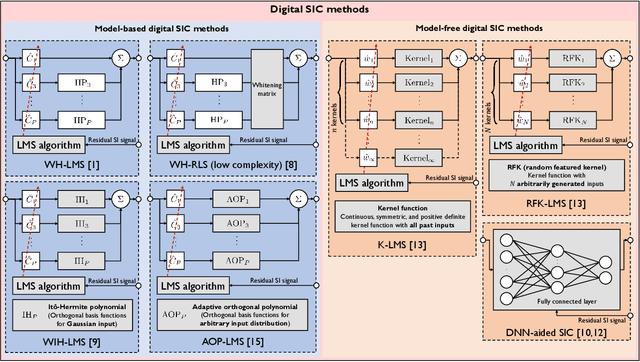
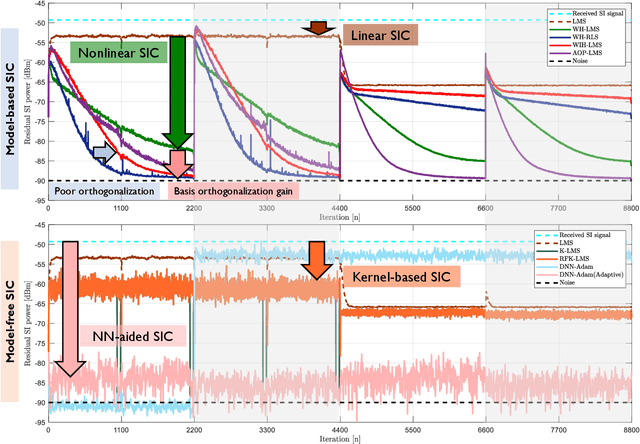
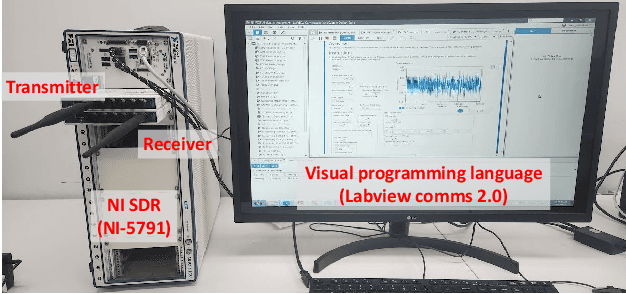
Abstract:Full-duplex communication systems have the potential to achieve significantly higher data rates and lower latency compared to their half-duplex counterparts. This advantage stems from their ability to transmit and receive data simultaneously. However, to enable successful full-duplex operation, the primary challenge lies in accurately eliminating strong self-interference (SI). Overcoming this challenge involves addressing various issues, including the nonlinearity of power amplifiers, the time-varying nature of the SI channel, and the non-stationary transmit data distribution. In this article, we present a review of recent advancements in digital self-interference cancellation (SIC) algorithms. Our focus is on comparing the effectiveness of adaptable model-based SIC methods with their model-free counterparts that leverage data-driven machine learning techniques. Through our comparison study under practical scenarios, we demonstrate that the model-based SIC approach offers a more robust solution to the time-varying SI channel and the non-stationary transmission, achieving optimal SIC performance in terms of the convergence rate while maintaining low computational complexity. To validate our findings, we conduct experiments using a software-defined radio testbed that conforms to the IEEE 802.11a standards. The experimental results demonstrate the robustness of the model-based SIC methods, providing practical evidence of their effectiveness.
Pooling Faces: Template based Face Recognition with Pooled Face Images
Jul 06, 2016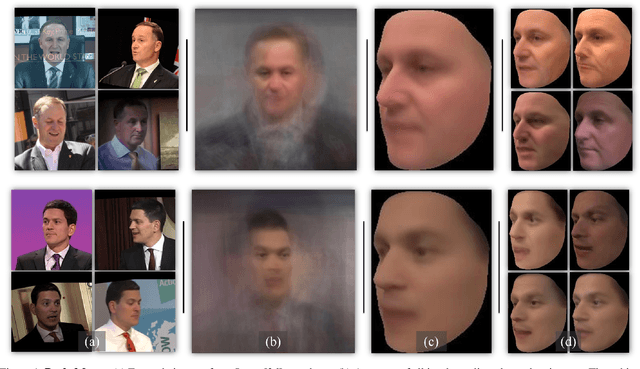



Abstract:We propose a novel approach to template based face recognition. Our dual goal is to both increase recognition accuracy and reduce the computational and storage costs of template matching. To do this, we leverage on an approach which was proven effective in many other domains, but, to our knowledge, never fully explored for face images: average pooling of face photos. We show how (and why!) the space of a template's images can be partitioned and then pooled based on image quality and head pose and the effect this has on accuracy and template size. We perform extensive tests on the IJB-A and Janus CS2 template based face identification and verification benchmarks. These show that not only does our approach outperform published state of the art despite requiring far fewer cross template comparisons, but also, surprisingly, that image pooling performs on par with deep feature pooling.
Face Recognition Using Deep Multi-Pose Representations
Mar 23, 2016


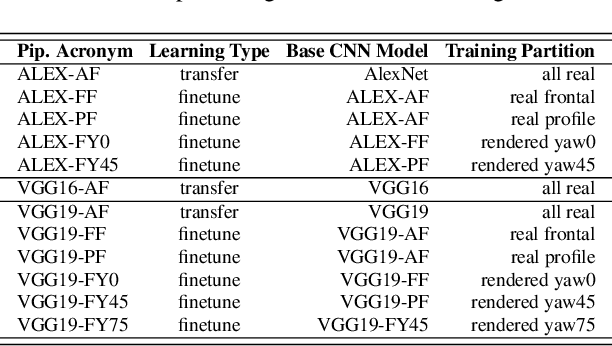
Abstract:We introduce our method and system for face recognition using multiple pose-aware deep learning models. In our representation, a face image is processed by several pose-specific deep convolutional neural network (CNN) models to generate multiple pose-specific features. 3D rendering is used to generate multiple face poses from the input image. Sensitivity of the recognition system to pose variations is reduced since we use an ensemble of pose-specific CNN features. The paper presents extensive experimental results on the effect of landmark detection, CNN layer selection and pose model selection on the performance of the recognition pipeline. Our novel representation achieves better results than the state-of-the-art on IARPA's CS2 and NIST's IJB-A in both verification and identification (i.e. search) tasks.
 Add to Chrome
Add to Chrome Add to Firefox
Add to Firefox Add to Edge
Add to Edge